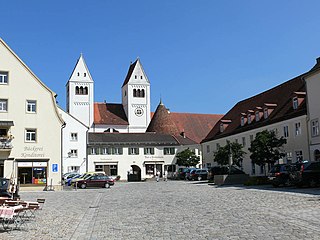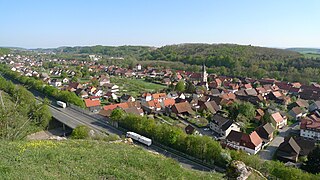
51°36′47″N10°18′32″E / 51.61313°N 10.30878°E Pöhlde Abbey was a Premonstratensian (previously Benedictine) monastery at Pöhlde, now a small village and part of the town of Herzberg am Harz, in Lower Saxony, Germany.

51°36′47″N10°18′32″E / 51.61313°N 10.30878°E Pöhlde Abbey was a Premonstratensian (previously Benedictine) monastery at Pöhlde, now a small village and part of the town of Herzberg am Harz, in Lower Saxony, Germany.
The lands of Pöhlde were given in dower in c 927 to Queen Matilda by her husband, Henry I the Fowler (d. 936). This is the earliest-written record of the place.
Dedicated to Saint John the Baptist and Saint Servatius, the abbey was founded in 952 by Matilda and received generous endowments from her son, Emperor Otto I. It benefited greatly from its close connection to the imperial palace then also situated at Pöhlde, and for a time was one of the wealthiest monasteries in Germany.
The foundation was originally for Canons regular, but it adopted the Rule of St. Benedict in 952. In 1131 it joined the Premonstratensian Order.
In 1200 the old Romanesque church burnt down. Its Gothic successor was consecrated in 1240.
In 1525 both church and monastery were destroyed by peasants from Eichsfeld in the Peasants' War. The monks moved to Duderstadt. In 1533 in the Reformation Duke Philip of Grubenhagen dissolved the abbey and took over its property.
In 1629 a brief attempt to revive the abbey ended in failure. Later in the Thirty Years' War what little remained on the site was completely destroyed. After the return of peace the present half-timbered village church was built on the foundations of the nave of the destroyed abbey church.
There are no visible traces of the abbey left. Between 1971 and 1974 the remains of the abbey were uncovered during archaeological excavations, but for their better preservation were covered over again. The remains of the palace, to which the abbey buildings were physically connected, were also excavated at about the same time, but were also covered over again.

Titchfield Abbey is a medieval abbey and later country house, located in the village of Titchfield near Fareham in Hampshire, England. The abbey was founded in 1222 for Premonstratensian canons, an austere order of priests. The abbey was a minor house of its order, and became neither wealthy nor influential during its three centuries of monastic life; the inhabitants were devoted to scholarship, as shown by their very impressive library.

Irsee Abbey, also the Imperial Abbey of Irsee, was a Benedictine abbey located at Irsee near Kaufbeuren in Bavaria. The self-ruling imperial abbey was secularized in the course of the German mediatization of 1802–1803 and its territory annexed to Bavaria. The buildings of the former abbey now house a conference and training centre for Bavarian Swabia.
Münsterschwarzach Abbey, is a monastery for Benedictine monks in Germany. It is located at the confluence of the rivers Schwarzach and Main in Bavaria.

Steingaden Abbey was a Premonstratensian monastery in Steingaden in Bavaria, Germany.

Volkenroda Abbey is a former Cistercian monastery in the municipality of Körner in the district Unstrut-Hainich-Kreis of Thuringia, Germany.

All Saints' Abbey was a Premonstratensian monastery near Oppenau in the Black Forest in Baden-Württemberg, Germany. It is located at 620 metres above sea level in the upper valley of the Lierbach.

Walkenried Abbey was a Cistercian abbey located in the village of Walkenried in Lower Saxony, Germany. Founded in 1127 on the southern rim of the Harz mountain range, the remnants of the monastic complex since 2010 are part of the Upper Harz Water Regale World Heritage Site.

Weissenau Abbey was an Imperial abbey (Reichsabtei) of the Holy Roman Empire located near Ravensburg in the Swabian Circle. The abbey, a Premonstratensian monastery, was an Imperial Estate and therefore its abbot had seat and vote in the Reichstag as a prelate of the Swabian Bench. The abbey existed from 1145 until the secularisation of 1802-1803.

Schussenried Abbey is a former Catholic monastery in Bad Schussenried, Baden-Württemberg, Germany. It is famed for its Baroque library hall. The abbey was established in the 12th century by the Premonstratensian Order and made an Imperial Abbey in the 15th century. The monastery sustained immense damage in the Thirty Years' War. In the 18th century, the abbey began expansions in the Baroque style, but was unable to complete them. The abbey was secularized in 1803 and twice awarded during the process of German Mediatization, eventually becoming a possession of the Kingdom of Württemberg. Its second king, William I, opened a foundry on its grounds, which was followed by a nursing home. These ceased operation or moved out of the monastery in the 1990s.
Ursberg Abbey is a former Premonstratensian monastery, now a convent of the Franciscan St. Joseph's Congregation, situated in the small village of Ursberg in the district of Günzburg, Bavaria.

Strahov Monastery is a Premonstratensian abbey founded in 1143 by Jindřich Zdík, Bishop John of Prague, and Vladislaus II, Duke of Bohemia. It is located in Strahov, Prague, Czech Republic.

Bebenhausen Abbey is a former Cistercian monastery complex located in Bebenhausen, Baden-Württemberg, Germany. The complex is also the location of Bebenhausen Palace, a hunting retreat created and maintained by two Kings of Württemberg. The complex was named a historic monument in 1974.
Pöhlde is a village in southern Lower Saxony in Germany. It is part of the town Herzberg am Harz. It has a population of 2207. Archaeological excavation has revealed traces of settlement dating to the 2nd through 4th centuries AD. The town is noted for its Benedictine abbey. The Annals of Pöhlde, an important 12th century historical text, were composed here.
Nienburg Abbey was a Benedictine monastery in Nienburg in Saxony-Anhalt, Germany.

Rot an der Rot Abbey was a Premonstratensian monastery in Rot an der Rot in Upper Swabia, Baden-Württemberg, Germany. It was the first Premonstratensian monastery in the whole of Swabia. The imposing structure of the former monastery is situated on a hill between the valleys of the rivers Rot and Haslach. The monastery church, dedicated to St Verena, and the convent buildings are an important part of the Upper Swabian Baroque Route. Apart from the actual monastic buildings, a number of other structures have been preserved among which are the gates and the economy building.

Bonne-Espérance Abbey was a Premonstratensian abbey that existed from 1130 to the end of the 18th century, located in Vellereille-les-Brayeux in the Walloon municipality of Estinnes, province of Hainaut, Diocese of Tournai, in present-day Belgium.
Eppenberg Charterhouse was a charterhouse, or Carthusian monastery, now a ruin, situated on the Eppenberg next to the Heiligenberg in Gensungen, now part of Felsberg in Hesse, Germany. It was established to replace a failing monastery of Premonstratensian canonesses.

Berne Abbey, a Dutch abbey of the Premonstratensians, or Norbertines, in Heeswijk, North Brabant, is a religious community in the Netherlands. It has 27 brothers and priests.

Scharzfeld is a village in the borough of Herzberg am Harz in the district of Göttingen in South Lower Saxony, Germany.

Cappenberg Castle is a former Premonstratensian monastery, Cappenberg Abbey in Cappenberg, a part of Selm, North Rhine-Westphalia in Germany. It stands on an elevation, the Cappenberg, near Lünen and Werne, and is a vantage point offering views over the eastern Ruhrgebiet.